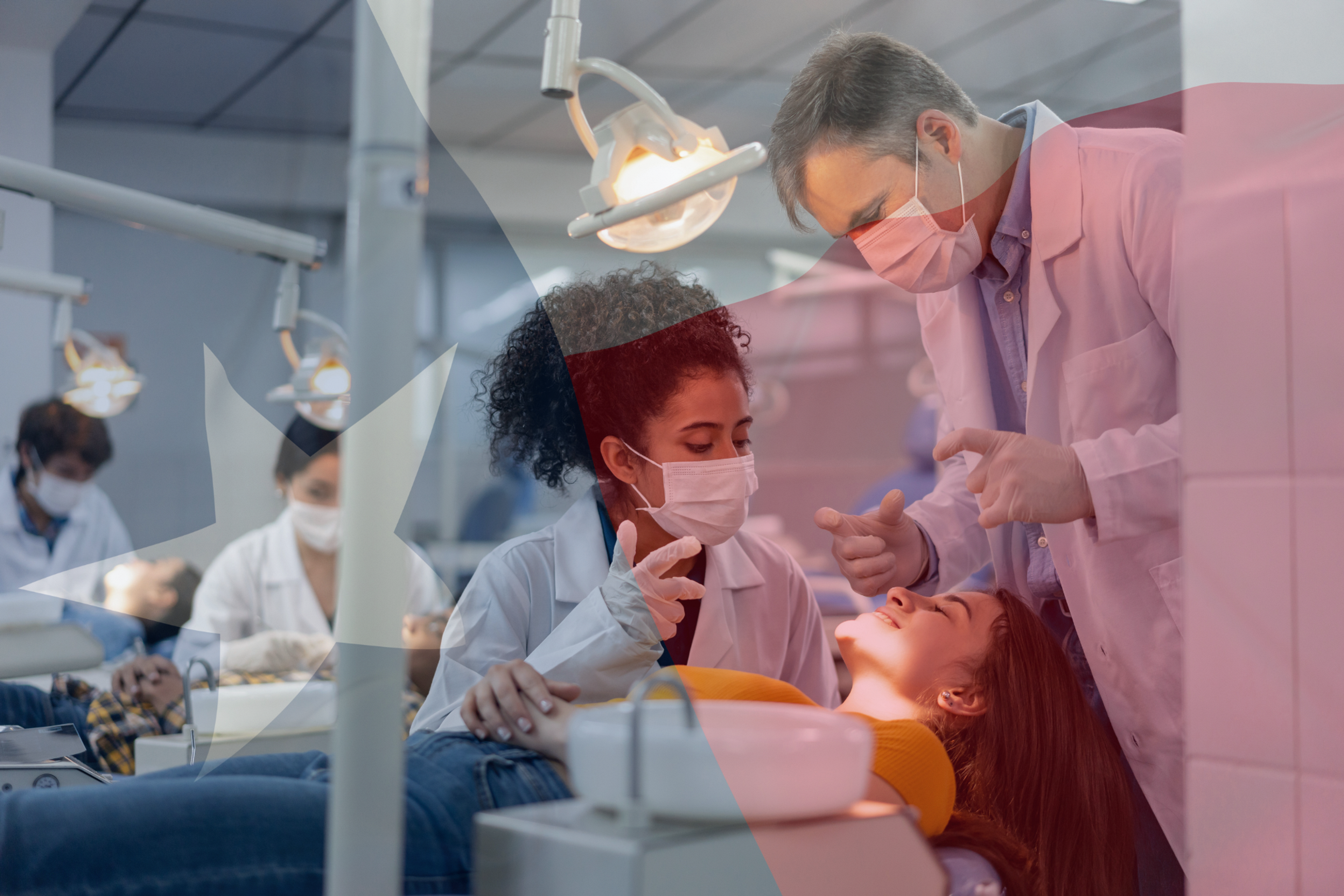An In-Depth Guide to the Dental School Application Timeline
Are you considering applying to dental school? Our comprehensive guide to the dental school application timeline will help you navigate the process from start to finish.
Posted July 16, 2025

Table of Contents
Applying to dental school is a rigorous and competitive process requiring meticulous planning and execution. This guide provides a detailed overview of the dental school application timeline to help prospective students navigate the journey effectively, from initial preparations to submission and beyond.
Why Early Preparation is Very Important
Starting early is critical in the dental school application process. Prospective applicants should focus on building strong academic foundations, particularly in science coursework, as top dental schools require specific prerequisite courses for admission.
Early preparation allows students to research individual schools, understand their unique requirements, and align their efforts with application deadlines.
Many dental schools, including public dental schools and Canadian dental schools, operate on a rolling admissions system, meaning earlier submissions often yield better outcomes. Understanding important dates and milestones, such as when to take the Dental Admission Test (DAT) and when applications open, can make a significant difference in securing an offer.
Read: The Complete Guide to the Dental School Application
Key Dates in the Dental School Application Timeline
| Months | Key Activities and Milestones |
|---|---|
| October - December 2024 | During this period, many dental schools continue their interview process. Schools typically begin sending acceptance offers on Decision Day (December 15th). Applicants on waitlists should consider sending letters of interest or updates to maintain communication with schools and demonstrate continued interest. |
| January - March 2025 | If you are on a waitlist, stay in contact with the schools, as additional offers may be extended during this time. Use these months to finalize financial aid, secure housing, and organize any remaining enrollment documents. This is also an excellent time to review materials and prepare for the academic challenges ahead. |
| April - June 2025 | Ensure that all required transcripts and letters of recommendation have been received by the schools. Begin organizing pre-enrollment materials and prepare for orientation events. Planning your transition into dental school during this time will set you up for success. |
| July - September 2025 | Late summer marks the start of orientation programs, which provide critical insights into your program's curriculum and expectations. In September, you will officially begin dental school, starting foundational courses such as anatomy, biochemistry, and clinical skills as you embark on your journey to becoming a dentist. |
Dental School Application Deadlines
Spring of the Application Year
The application journey begins in the spring, an essential time for gathering and organizing all application materials. These materials include transcripts, letters of recommendation, and a compelling personal statement. Applicants should also schedule and prepare to take the DAT, as achieving competitive scores is a crucial component of the dental school application process. Early preparation during this period sets the stage for a successful application.
Early May to Early June
The ADEA AADSAS application portal typically opens in early May, marking the official start of the application cycle. Applicants can begin completing their primary application at this time. Submitting early ensures a competitive advantage, as most dental schools operate on a rolling admissions basis and process applications in the order they are received. By early June, many schools start reviewing completed applications, which can lead to earlier interview invitations.
Summer: Submission and Interviews
During the summer, applicants must finalize and submit their applications through ADEA AADSAS. At this stage, strong letters of recommendation from science professors or dentists can provide valuable insights into the applicant's qualifications. Many dental schools require supplemental applications during this period, offering an opportunity for applicants to provide additional details about their achievements and experiences.
Summer is also when schools begin scheduling interviews. This critical phase evaluates applicants’ communication skills, professionalism, and dedication to a career in dentistry. Thorough preparation for interviews is essential, as they are often a decisive factor in the admission process.
Fall and Winter: Decisions and Final Steps
By late fall, many dental schools start extending offers to their most qualified candidates, often beginning on Decision Day (December 15th). This period is crucial for applicants to evaluate their options, compare financial aid offers, and decide which school aligns best with their goals. Accepted applicants may have to provide a financial deposit to secure their spot. Waitlisted students should maintain contact with schools and submit letters of interest if appropriate.
By the winter months, most applicants receive their final acceptance decisions, concluding the application and admissions cycle and preparing for the next stage of their dental education.
The Common Challenges and How to Overcome Them
Meeting Deadlines
One of the biggest obstacles in the dental school application process is managing deadlines, especially for schools with rolling admissions. Late submissions can greatly reduce your chances of acceptance, as spots fill up quickly. To overcome this challenge, create a detailed dental school application timeline with key milestones, such as completing the ADEA AADSAS application, submitting supplemental applications, and preparing for interviews. Setting internal deadlines ahead of the official ones can help you stay on track and account for unexpected delays. Additionally, using a checklist to track all required application materials, including transcripts, letters of recommendation, and test scores, ensures that nothing is overlooked.
Securing Strong Letters of Recommendation
Obtaining impactful letters of recommendation can be challenging, as it requires careful planning and building strong relationships with recommenders. Start early by reaching out to science professors, dentists, or mentors to give them ample time to write thoughtful letters. To make the process easier for them, provide a list of your achievements, experiences, and goals, which can help them craft a more personalized and detailed letter. Following up with polite reminders about deadlines and expressing gratitude for their support can also ensure you receive the best possible letters.
Tailoring Applications to Individual Schools
Underestimating the importance of tailoring your application is a common pitfall. Each dental school has unique priorities, values, and cultures. To stand out, research each program thoroughly by reviewing their website and mission statement to understand what they value most, whether it’s clinical experience, research, or community service. Customize your personal statement to highlight experiences and qualities that align with the school’s mission and demonstrate why you are a great fit. Be sure to address school-specific requirements, as some schools may have unique essay prompts or prerequisites, and meeting these expectations can strengthen your application.
Effective Strategies for Applying to Dental School
- Focus on academics - Strong academic performance is fundamental to a competitive dental school application. High grades, particularly in prerequisite science courses such as biology, chemistry, and anatomy, demonstrate your readiness to handle the rigorous coursework of dental school.
To achieve this, create a study schedule that prioritizes these subjects and seek academic support, such as tutoring or study groups, if needed. Maintaining a solid GPA also helps you stand out among applicants. - Excel in the DAT - The DAT (Dental Admission Test) is one of the most important components of your application. A high score not only fulfills admissions requirements but also strengthens your overall profile. Begin preparing for the DAT at least six months in advance by using reputable resources such as DAT prep courses, practice tests, and study guides.
Focus on key sections, including biology, general chemistry, organic chemistry, and quantitative reasoning. If your first attempt doesn’t yield the desired results, consider retaking the test, but plan strategically to avoid delaying your application timeline. - Highlight relevant experience - Demonstrating your commitment to dentistry through relevant experiences can make your application stand out. Seek opportunities to gain hands-on exposure, such as clinical shadowing, volunteering at dental clinics, or participating in dental-related research.
These activities show your passion for the field and your understanding of its demands. Additionally, taking on leadership roles in dental organizations or community service projects can further showcase your dedication and ability to lead. - Prepare for interviews - Dress professionally, arrive on time, and engage actively during the interview to leave a strong impression. The dental school interview is a critical step in the admissions process, as it allows schools to evaluate your communication skills, professionalism, and fit for their program. Research each school thoroughly to understand its mission, values, and specific program details.
Practice answering common interview questions, such as those about your motivation for pursuing dentistry, your relevant experiences, and your future goals. Conduct mock interviews with mentors, top dental school coaches, or peers to build confidence and improve your delivery.
Financing Dental School
Financing dental school is a significant consideration for prospective students, as tuition and living expenses can range from $200,000 to over $500,000 for the entire program. However, a combination of scholarships, grants, loans, and strategic planning can make these costs manageable. By understanding the available options and preparing early, applicants can reduce their financial burden and focus on their academic and career goals.
Here are the important things that you must know:
- Scholarships are a vital funding source as they do not require repayment. Many dental schools offer merit-based or need-based scholarships, and organizations like the American Dental Association (ADA), National Health Service Corps (NHSC), and Army Health Professions Scholarship Program (HPSP) provide significant opportunities. Research and apply early to meet application deadlines.
- Grants can help reduce financial burden without repayment requirements. Federal grants, such as the Pell Grant, can be accessed through the FAFSA, and some dental schools provide institutional grants based on financial need.
- Loans are a common way to finance dental school and include federal options like the Direct Unsubsidized Loan and Direct PLUS Loan. These loans offer lower interest rates and flexible repayment options compared to private loans. Private loans are an alternative but should be carefully evaluated.
- Loan forgiveness programs can offset debt through options like the National Health Service Corps Loan Repayment Program, Public Service Loan Forgiveness (PSLF), or state-specific programs. These often require service in underserved or public health settings.
- Work-study and part-time jobs can provide additional income through campus-based roles or positions such as research assistantships. These jobs are a flexible way to earn money without interfering significantly with your studies.
- Budgeting and financial planning are essential for managing expenses such as tuition, fees, housing, and supplies. Use tools like the ADEA Cost Calculator to estimate costs and look for ways to save, like sharing housing or purchasing used textbooks.
How Top Dental School Coaches Can Help
Applying to dental school is a challenging and competitive process, but top dental school coaches can make a significant difference in helping applicants succeed. These professionals provide tailored support at every stage, from choosing the right schools to crafting a standout application. With their insider knowledge of what admissions committees look for, coaches can help you avoid common mistakes and maximize your strengths.
Whether it’s refining your personal statement, preparing for interviews, or navigating the dental school application timeline, a coach offers personalized guidance that keeps you focused and confident. They understand how to align your experiences with the values and missions of each program, ensuring your application stands out. With the expertise of a trusted coach, you can approach the process strategically, stay organized, and increase your chances of gaining admission to your top-choice dental school.
Read: The 10 Best Dental Coaches for Application & Interview Prep
Read next:
- Dental School Interview Guide
- Should You Become a Dentist? Pros, Cons, and How to Decide
- How Hard Is It (Actually) to Become a Dentist?
- The Different Types of Medical Careers – and Which One is Right for You
- How to Ace the Dental Admission Test (DAT): 5 Tips for Success
- What Do You Learn in Dental School?
FAQs
What is the ADEA AADSAS, and how does it facilitate the dental school application process?
- The American Dental Education Association's Associated American Dental Schools Application Service (ADEA AADSAS) is a centralized application service that allows applicants to submit a single application to multiple dental schools. This streamlines the process by reducing the need to complete separate applications for each institution. Applicants should be aware of the specific requirements and deadlines of each school they are applying to, as they can vary.
How do I determine which dental schools are the best fit for me?
- Selecting the right dental school involves considering factors such as program curriculum, location, cost, class size, clinical experience opportunities, and school culture. It's advisable to research each school's offerings and admissions criteria thoroughly. Resources like the ADEA Official Guide to Dental Schools provide comprehensive information to assist in making informed decisions.
What are Letters of Evaluation (LOEs), and how do they impact my application?
- Letters of Evaluation, commonly known as letters of recommendation, are assessments written by individuals who can attest to your qualifications and readiness for dental school. While not required to complete the ADEA AADSAS application, most dental schools require LOEs to review your application. It's important to choose evaluators who know you well and can provide detailed insights into your abilities and character.
What is the role of secondary applications in the dental school admissions process?
- In addition to the primary application submitted through ADEA AADSAS, many dental schools require a secondary application. These applications often request additional information, such as essays or short-answer responses, to gain a deeper understanding of the applicant. There is usually a fee associated with secondary applications, and the content and requirements can vary by school.
How can I strengthen my dental school application if my academic metrics are below average?
- If your GPA or DAT scores are below the average for admitted students, you can enhance your application by gaining substantial experience in the dental field, such as shadowing dentists, participating in relevant research, or engaging in community service related to healthcare. Additionally, a compelling personal statement and strong Letters of Evaluation can help offset lower academic metrics by highlighting your passion, commitment, and suitability for a career in dentistry.











